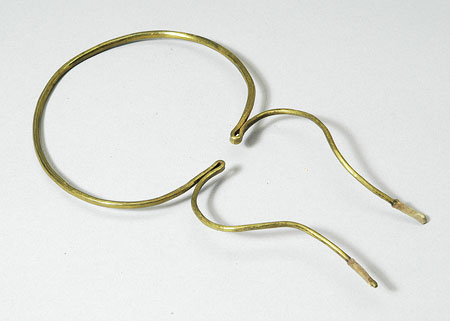Lokoya torque

Accession Number:
1940.7.079
Country:
Sudan
Region:
[Southern Sudan] [Al Istiwa'iyah] [Equatoria] Bahr el Jebel Eastern Equatoria ?Western Equatoria Langabu
Cultural Group:
Lokoya ?Irya and Owe
Date Made:
By 1940
Materials:
Brass Metal , Animal Hide Skin
Process:
Hammered , Bent , Covered
Dimensions:
Max L = 216 mm Max W = 123 mm Max Diam [internal] = 115 mm Max W [rod] = 3.7 mm Max th = 3.2 mm
Weight:
48.6 g
Other Owners:
Samuel P. Powell
Field Collector:
Samuel P. Powell
PRM Source:
Samuel P. Powell
Acquired:
Loaned July 1940
Collected Date:
By 1940
Description:
Penannular torque made from a brass rod, bent into a roughly circular loop with open ends, 14 mm apart.
The ends have been doubled back on themselves and hammered flat, running parallel with the outer face of the necklet; these then become round in section once more and continue as long projections that curve out, and then in again, creating Z and S shapes that mirror one another on either side of the torque opening.
The tips are blunt, and have been covered in narrow hide sheaths, with some hair visible in places, that fit over each end and are approximately 18 mm long.
One sheath continues over the tip; the other ends just below it.
Neither sheath has any visible seams and may have been taken from the tail of a small animal.
The object is complete and intact, and currently a metallic yellow colour (Pantone 871C).
It measures 123 mm across the width, 216 mm across the length, including the arms, and has an internal diameter of 115 by 104 mm.
The rod from which it has been shaped is 3.7 mm wide and 3.2 mm thick.
It has a weight of 48.6 grams.
Collected by Samuel P. Powell from the 'Oxoriok' at Langabu, and loaned to the Pitt Rivers Museum in 1940. Oxoriok is another name for the Lokoya. For discussions of the Lokoya, see G.W.B. Huntingford, 1953, The Northern Nilo-Hamites, p. 75-78, and C.G. Seligman, Pagan Tribes, pp 340-345. The precise location of Langabu has yet to be established.
This type of necklet was worn by girls. For similar neck ornaments in iron, see 1934.8.67 and 1940.7.080 (Lotuko and Lokoya) and 1934.8.52 (Bari). Gayer-Anderson illustrates a torque of similar design, which he says was worn by Kederu women, for 'cosmetic effect' and as a 'sign of wealth and for self defence. One has seen severe septic wounds inflicted by such ornaments' (R. Gayer Anderson, 1911, "Some Tribal Customs in their Relation to Medicine & Morals of the Nyam-Nyam and Gour Peoples Inhabiting The Bahr-el-Ghazal", Wellcome Tropical Research Laboratories, Khartoum, rep. no. 4, vol. B, pl. XVIII no. 11). In this case, the hide sheaths would protect the wearer from inflicting damage. The projecting ends seen on this necklet are also found on iron bracelets (see 1884.82.53). Coote has suggested that these have been shaped into the form of trained cow horns (Jeremy Coote, pers. comm. 15/1/ 2002).
Rachael Sparks 14/9/2005.
Collected by Samuel P. Powell from the 'Oxoriok' at Langabu, and loaned to the Pitt Rivers Museum in 1940. Oxoriok is another name for the Lokoya. For discussions of the Lokoya, see G.W.B. Huntingford, 1953, The Northern Nilo-Hamites, p. 75-78, and C.G. Seligman, Pagan Tribes, pp 340-345. The precise location of Langabu has yet to be established.
This type of necklet was worn by girls. For similar neck ornaments in iron, see 1934.8.67 and 1940.7.080 (Lotuko and Lokoya) and 1934.8.52 (Bari). Gayer-Anderson illustrates a torque of similar design, which he says was worn by Kederu women, for 'cosmetic effect' and as a 'sign of wealth and for self defence. One has seen severe septic wounds inflicted by such ornaments' (R. Gayer Anderson, 1911, "Some Tribal Customs in their Relation to Medicine & Morals of the Nyam-Nyam and Gour Peoples Inhabiting The Bahr-el-Ghazal", Wellcome Tropical Research Laboratories, Khartoum, rep. no. 4, vol. B, pl. XVIII no. 11). In this case, the hide sheaths would protect the wearer from inflicting damage. The projecting ends seen on this necklet are also found on iron bracelets (see 1884.82.53). Coote has suggested that these have been shaped into the form of trained cow horns (Jeremy Coote, pers. comm. 15/1/ 2002).
Rachael Sparks 14/9/2005.
Primary Documentation:
Accession Book Entry
[Loans II, p.
308] - ESTATE OF S.P.
POWELL, C/O N.H.
HASLAM, Esq.
Manager, Westminster Bank, Stony Stratford, Bucks.
Collected by himself.
Data from his labels and notes.
[p.
313] 1940.7.079 - Girl's neck ornament, brass.
OXORIOK.
From LANGABU.
EQUATORIAL PROVINCE, [insert] A[NGLO].-E[GYPTIAN].
[end insert] SUDAN.
Card Catalogue Entry - There is no further information on the catalogue card [RTS 28/1/2004].
Pitt Rivers Museum label - Girl's neck ornament, brass. OXORIOK Langabu, Sudan, Equatorial Province. S.P. Powell 1940.7.079 [brown luggage tag, tied to object; RTS 1/3/2005].
Related Documents File - Appears on undated typed list: "Oxoriok neck ornaments in brass and iron from Langabu E.P.". List is annotated by hand on back: "List of Curios" and "Far from complete". For the iron neck ornament, see 1940.7.080 [RTS 16/12/2003].
Card Catalogue Entry - There is no further information on the catalogue card [RTS 28/1/2004].
Pitt Rivers Museum label - Girl's neck ornament, brass. OXORIOK Langabu, Sudan, Equatorial Province. S.P. Powell 1940.7.079 [brown luggage tag, tied to object; RTS 1/3/2005].
Related Documents File - Appears on undated typed list: "Oxoriok neck ornaments in brass and iron from Langabu E.P.". List is annotated by hand on back: "List of Curios" and "Far from complete". For the iron neck ornament, see 1940.7.080 [RTS 16/12/2003].

